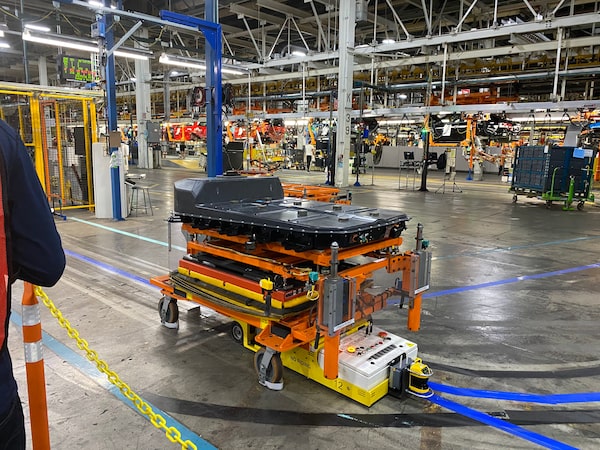
An EV battery meant for the electric Chevy Bolt sits on a trolley at the General Motors' Orion plant in Michigan.Jason Tchir/The Globe and Mail
Imagine for a moment what would happen if Canada’s auto industry was sucked away into the United States. Tens of thousands of jobs and a big chunk of the $19-billion a year the sector contributes to Canada’s gross domestic product would slip away. How much would a Canadian government pay to stop that?
That’s a question the current government in Ottawa seems to think it is facing. It’s a debatable point in and of itself, but the Liberals are out to secure electric-vehicle battery plants in Canada because they think that is key to keeping an active auto industry in Canada – and also that it will build a battery sector, too.
Still, there is an unanswered question: How much should we pay? That question is curiously absent from Canada’s political debate, though the scale of the potential sums is enormous because of the massive subsidies in the U.S. Inflation Reduction Act.
If you look closely at a recent report on green-technology incentives by Clean Prosperity and The Transition Accelerator, it provides an idea of how much it would cost to compete with U.S. incentives for two EV battery plants: roughly $40-billion.
According to the report, one EV battery plant in Tennessee with a production capacity of 45 gigawatt hours would receive roughly $2-billion a year more in subsidies than a comparable plant in Ontario. If Canada wants to compete with a decade of such subsidies, it would cost $20-billion for one plant. And we would probably want to compete for two or three.
As it happens, auto maker Stellantis N.V. is already building a plant just like that – a 45-gigawatt-hour EV battery plant in Windsor in partnership with South Korean battery company LG Energy Solution. But imagine if they threatened to pick up sticks and build in Michigan instead. What would the government of Canada pay to keep it in Windsor?
At the moment, Innovation Minister François-Philippe Champagne is trying to convince Volkswagen to set up a battery plant in Canada. According to the Financial Times, Volkswagen is putting plans for a European battery plant on hold because it can get €10-billion – nearly $15-billion – in subsidies for a North American plant.
These are massive sums. And the thing is, it’s not just about one battery plant, or the auto sector. The incentives in the U.S. Inflation Reduction Act and the U.S. CHIPS and Science Act include massive subsidies for all kinds of green technology and advanced manufacturing. The Biden administration has embarked on a massive effort to “reshore” manufacturing to the U.S. and transform industry for a low-carbon future.
That has launched a great subsidy war that will affect a lot of Canadian industry – not just cars but oil and gas and cement and hydrogen and solar panels. Finance Minister Chrystia Freeland is working on a Canadian response expected in this spring’s budget. Canada is deciding what it will back in the subsidy war, and to what extent, and oddly, there isn’t much political debate about it. The Liberals haven’t revealed sums. The Conservatives don’t seem to have a position.
If subsidies for EV battery plants were just to get the factories themselves, they obviously would not be worthwhile.
But the auto sector has long argued that it is worth subsidizing assembly plants as anchor investments that create jobs at parts suppliers and other companies. And now some argue that once a car maker sets up a battery plant, it is more likely to build an assembly plant nearby, with all the spinoffs. But the cost is enormous.
Then there is the suggestion that the Inflation Reduction Act and the subsidy war it has launched is something new and different – that it is not just more corporate welfare, but a transition point, and the start of a decade-long scramble in which countries will compete to build their industrial base for the next 50 years. The argument is that those who don’t scramble to buy themselves a comparative advantage won’t have one, and they won’t have an industrial base.
Mr. Champagne argued battery plants would fit into a Canadian supply chain that starts with minerals such as lithium and nickel and moves up the value chain. Whether that is really a valuable advantage is debatable, but even if you accept that it is, at some point, the cost is so high that there are better bets. So how much is Canada willing to pay?
 Campbell Clark
Campbell Clark